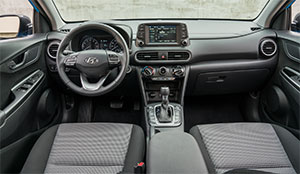2018 Hyundai Kona
It’s an all-new automotive impulse to buy now and it’s from Hyundai. It’s cute, cool, and it’s called Kona; so, time to brush off all of our Hawaii and surfer clichés as we find out what Hyundai’s smallest, most stylish crossover yet, has to offer. So, hang 10 with us, and ride the wave, as Kona erupts on the big island of subcompact crossovers.
Well, you can say one thing for the all-new 2018 Hyundai Kona, it sure knows how to make an entrance.
There are certainly familiar Hyundai styling elements, but this cute-ute takes things towards a much more sporty and visually aggressive direction.
Our Pulse Red tester is one of the tamer color options available; and throughout the design you’ll find lots of body sculpting, exaggerated “black armor” fender flares, and a fast tapered rear that has a passing nod to the Porsche Macan.
 Like most in its segment, the Kona targets urban adventurers; city dwellers that like to go exploring on the weekends. It fits well with a nimble chassis that puts the Kona squarely on the entertaining side of subcompact crossovers.
Like most in its segment, the Kona targets urban adventurers; city dwellers that like to go exploring on the weekends. It fits well with a nimble chassis that puts the Kona squarely on the entertaining side of subcompact crossovers.
But, you’ll find a limited space for outfitting those adventures; 19.2 cubic-ft., which expands to 45.8 with seatbacks folded. Lower trims are fitted with a 147-horsepower naturally-aspirated 2.0-liter I4 and 6-speed auto combo.
Upper trims get a smaller but mightier 1.6-liter I4 turbo that rates 175-horsepower and 195 lb-ft. of torque. It works with a 7-speed EcoShift DCT.
If you can afford to upgrade, by all means do it; as the 1.6-liter and DCT team is quite competent if still a little sluggish off the line.
All-wheel-drive is available with either engine and any trim, or you can stick with front-wheel-drive. But, if you do opt for AWD, in addition to all-weather capabilities, you get a better suspension setup; as it replaces the standard rear torsion beam, with an independent dual-arm multi-link design.
And we found that setup quite responsive at our test track; with good balance and agile nature, that made it very enjoyable to toss around.
 Understeer will show up when you really start pushing hard, but it arrives gradually, with plenty of warning so that you can easily keep it right at the limit.
Understeer will show up when you really start pushing hard, but it arrives gradually, with plenty of warning so that you can easily keep it right at the limit.
As mentioned before, things are a little slow to get going; but the little turbo eventually wakes up, and starts delivering power with a purpose, shuttling us to 60 in a good 7.0-seconds flat.
The 7-speed feels fully engaged in the mission as well, delivering solid and speedy shifts throughout the ¼-mile run; which took 15.5-seconds at 89 miles-per-hour.
A short 115-feet was our average stopping distance from 60. Some fade did creep in after multiple runs, but the Kona maintained its course with zero lateral backtalk and minimal nose dive.
Things inside are not quite as exciting as the outside. But, it is a very functional space, that also seems very durable.
All trims get a dash-top touchscreen; 7-inches in size on lower trims, 8.0-inches for the upgrade. Ultimate trim is where you want to be if you want the most trinkets. Included is a power sunroof, push button start, leather seats, LCD multi-information display, navigation, Head-Up display, and a 315-watt 8-speaker Infinity premium audio system.
 Seats are firm, and the room up front is a little tight. But, back seat passengers do better, as legroom in the rear is actually quite ample; though taller passengers will have to enter with care, to avoid hitting their head in the relatively small opening.
Seats are firm, and the room up front is a little tight. But, back seat passengers do better, as legroom in the rear is actually quite ample; though taller passengers will have to enter with care, to avoid hitting their head in the relatively small opening.
Forward Collision-Avoidance Assist autonomous braking is available, and it performed quite well in our barrier test; bringing us to smooth and quick halts 100% of the time at speeds up to 20 miles-per-hour.
Government Fuel Economy Ratings for the all-wheel-drive 1.6-liter are 26-City, 29-Highway, and 27-Combined. Our average was right on, at 27.5 miles-per-gallon of Regular. For a just about average for the Energy Impact Score; 12.2-barrels of oil used yearly with 5.4-tons of CO2 emissions.
Kona pricing starts at $20,480, the expected volume leader SEL model comes in at $23,630, with top trim Ultimate going for $28,380; all-wheel-drive adds $1,300 more.
Now, it won’t be easy for the 2018 Hyundai Kona to make a big splash in the crowded subcompact crossover pool; or to become the Big Kahuna if you will. But it should do “totally tubular” in this rapidly expanding class. And if there’s one thing that Hyundai still knows how to do, it’s deliver a lot of coconuts for less.
Specifications
- Engine: 1.6 liter
- Horsepower: 175
- Torque: 195 lb-ft.
- 0-60 mph: 7.0 seconds
- 1/4 mile: 15.5 seconds @ 89 mph
- EPA: 26 mpg city / 29 mpg highway
- Energy Impact: 12.2 barrels of oil/yr
- CO2 Emissions: 5.4 tons/yr






